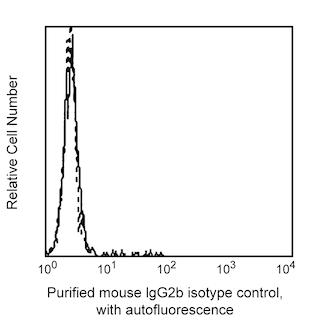Old Browser
Looks like you're visiting us from {countryName}.
Would you like to stay on the current country site or be switched to your country?




Flow cytometric analysis of CD86 expression on Daudi cell lines. Daudi cells were stained with either Purified Mouse Anti-Human CD86 (Cat. No. 555663; solid line histogram) or Purified Mouse IgG2b κ Isotype Control (Cat. No. 555740; dashed line histogram), followed by FITC Goat Anti-Mouse IgG/IgM (Cat. No. 555988). Fluorescent histograms were derived from gated events with the forward and side light-scattering characteristics of viable cells. Flow cytometry was performed on a BD FACScan™ system.


BD Pharmingen™ Purified Mouse Anti-Human CD86

Regulatory Status Legend
Any use of products other than the permitted use without the express written authorization of Becton, Dickinson and Company is strictly prohibited.
Preparation And Storage
Product Notices
- Since applications vary, each investigator should titrate the reagent to obtain optimal results.
- An isotype control should be used at the same concentration as the antibody of interest.
- Caution: Sodium azide yields highly toxic hydrazoic acid under acidic conditions. Dilute azide compounds in running water before discarding to avoid accumulation of potentially explosive deposits in plumbing.
- Sodium azide is a reversible inhibitor of oxidative metabolism; therefore, antibody preparations containing this preservative agent must not be used in cell cultures nor injected into animals. Sodium azide may be removed by washing stained cells or plate-bound antibody or dialyzing soluble antibody in sodium azide-free buffer. Since endotoxin may also affect the results of functional studies, we recommend the NA/LE (No Azide/Low Endotoxin) antibody format, if available, for in vitro and in vivo use.
- Please refer to www.bdbiosciences.com/us/s/resources for technical protocols.
Companion Products



.png?imwidth=320)
The IT2.2 monoclonal antibody specifically binds to CD86. CD86 is a ~ 75 kDa type I transmembrane glycoprotein which is also known as B7-2 or B70. CD86 is primarily expressed on monocytes, dendritic cells, Langerhans cells, and activated B cells including B lymphoid cells in germinal centers and Epstein-Barr virus transformed B-cell lines. CD86 is a ligand for CD28 and CD152 (CTLA-4) and may play an important role in costimulation of T cells in primary immune responses. Competitive binding assays demonstrate that, while both the IT2.2 and FUN-1 monoclonal antibodies recognize the same CD86 molecule, they react with different epitopes. IT2.2 blocks the costimulation activity of CD86 in functional studies and blocks binding of human CTLA-4-Ig fusion protein to CD86 gene-transfected cells.
Development References (5)
-
Azuma M, Ito D, Yagita H, et al. B70 antigen is a second ligand for CTLA-4 and CD28.. Nature. 1993; 366(6450):76-9. (Biology). View Reference
-
Engel P, Gribben JG, Freeman GJ, et al. The B7-2 (B70) costimulatory molecule expressed by monocytes and activated B lymphocytes is the CD86 differentiation antigen. Blood. 1994; 84(5):1402-1407. (Biology). View Reference
-
Engel P, Wagner N, Tedder TF. CD86 Workshop Report. In: Schlossman SF. Stuart F. Schlossman .. et al., ed. Leucocyte typing V : white cell differentiation antigens : proceedings of the fifth international workshop and conference held in Boston, USA, 3-7 November, 1993. Oxford: Oxford University Press; 1995:703-705.
-
Hardie DL, Casamayor M, Johnson GD, et al. CD86 Workshop Panel report. In: Kishimoto T. Tadamitsu Kishimoto .. et al., ed. Leucocyte typing VI : white cell differentiation antigens : proceedings of the sixth international workshop and conference held in Kobe, Japan, 10-14 November 1996. New York: Garland Pub.; 1997:201-204.
-
Nozawa Y, Wachi E, Tominaga K, Abe M, Wakasa H. A novel monoclonal antibody (FUN-1) identifies an activation antigen in cells of the B-cell lineage and Reed-Sternberg cells. J Pathol. 1993; 169(3):309-315. (Biology). View Reference
Please refer to Support Documents for Quality Certificates
Global - Refer to manufacturer's instructions for use and related User Manuals and Technical data sheets before using this products as described
Comparisons, where applicable, are made against older BD Technology, manual methods or are general performance claims. Comparisons are not made against non-BD technologies, unless otherwise noted.
For Research Use Only. Not for use in diagnostic or therapeutic procedures.
Refer to manufacturer's instructions for use and related User Manuals and Technical Data Sheets before using this product as described.
Comparisons, where applicable, are made against older BD technology, manual methods or are general performance claims. Comparisons are not made against non-BD technologies, unless otherwise noted.
Report a Site Issue
This form is intended to help us improve our website experience. For other support, please visit our Contact Us page.